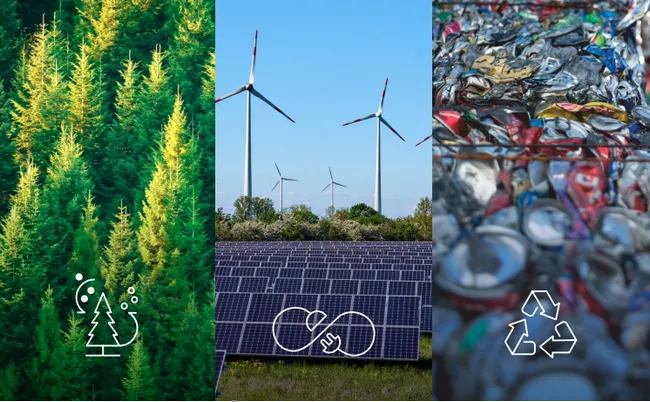Zero Emissions Day: Pulling back from the brink
- Copy
When it comes to climate change, the scientific consensus is clear. We must all do our fair share to reduce greenhouse gas (GHG) emissions or risk irreversible, possibly catastrophic, consequences. Zero Emissions Day, observed every year on September 21, is a timely reminder of the importance of decarbonisation. It also happens to be a top operational priority for Aditya Birla Group.
Zero Emissions Day was first observed in 2008 as a day for Earth to ‘take a break’ from fossil fuel consumption. In recent years, many nations including India have taken on tough commitments to slash their carbon-intensity. As a partner in the nation’s clean energy journey, Aditya Birla Group supports these commitments through a slew of measures aimed at reducing its own energy consumption and GHG emissions.

Decarbonisation roadmap
Not long ago, Aditya Birla Group publicly announced its intention to achieve net-zero emissions by 2050. Since Hindalco, Novelis, Birla Carbon, Grasim, and UltraTech collectively represent 96% of the Group’s overall GHG emissions, all these companies have undertaken a combination of short, medium, and long-term decarbonisation projects.
These projects fall into four broad categories: using renewable and alternative energy sources; energy efficiency and conservation; carbon mitigation and sequestration; and low-carbon growth and product stewardship
Let’s look at the initiatives under each category.
Renewable and alternative energy: The Group has made strides in adopting cleaner energy sources. For instance, its metals flagship Hindalco has installed renewable energy capacity of 49 megawatts (MW) and plans to increase this to 100 MW by 2023. UltraTech, the cement flagship, plans to meet 100% of its electricity requirement through renewable sources by 2050.
Energy efficiency and conservation: This involves measures to reduce, conserve and recover energy. UltraTech’s Waste Heat Recovery System (WHRS), for example, recovers heat and waste gases released during cement-making and uses it to run steam-powered generators. The company plans to more than double the WHRS’s power-generation capacity to 302 MW by 2024. Similar measures by other Group companies are also helping improve energy efficiency and slash emissions.
Carbon mitigation and sequestration: The Group is committed to reducing its GHG emissions by capturing and storing atmospheric carbon dioxide. This process is known as carbon sequestration. Birla Cellulose is a great example here. By focusing on energy efficiency, renewable energy usage, and reforestation, Birla Cellulose has become the first company in the manmade cellulosic fibre industry to be carbon neutral in its directly-managed forests.
Low-carbon growth and product stewardship: Aditya Birla Group businesses are aiming for circularity in order to move towards low-carbon growth. This involves trying to find ways to maximise the usage of post-consumer waste. For example, Novelis (a division of Hindalco) has pioneered a closed loop recycling system that takes aluminium scrap generated by automakers and reforms it into metal of the same calibre to be used again in the supply chain.
Sustainability commitments
All Aditya Birla Group companies have taken on ambitious decarbonisation targets. Here’s a look at the individual targets and strategies announced by different companies.
Hindalco
By 2025, the Group’s metals flagship Hindalco aims to reduce its emission intensity by 25% compared to 2012 levels. It will do this by developing a mitigation strategy based on three emission reduction pathways – electricity decarbonisation, direct emissions reduction, and recycling and resource efficiency.
Novelis
The world’s largest and most technologically advanced aluminium recycler plans to reduce 30% of its carbon emissions by committing to a circular economy, growing high-recycled content products, making investments to add recycling capacity, applying sustainable sourcing strategies, implementing renewable energy projects, and decreasing overall energy use.
Birla Cellulose
Birla Cellulose plans to reduce its GHG intensity by 30% by 2030 and achieve carbon neutrality by 2040. It will do this by increasing the use of renewable energy and reducing the use of power and steam. Its commitment to sequestration in its directly-managed forests will also go a long way in helping Birla Cellulose reduce its net emissions.
UltraTech
As India’s leading cement producer, UltraTech’s low-carbon growth trajectory will enable it to cut CO2 emissions by 25% by 2030. Towards this end, UltraTech will undertake product diversification, accelerate investments in low-carbon technologies, and enhance resource efficiency by scaling up utilisation of industrial waste material.
Birla Carbon
Driven by a commitment to bring down its net carbon emissions to zero by 2050, Birla Carbon is investing in advanced technologies to upgrade its sites. These upgraded sites will target carbon capture and conversion by increasing the use of bio-based feedstock and advancing the development of circular products.
Aditya Birla Fashion and Retail (ABFRL)
In order to meet its emission reduction goals for 2025, ABFRL is using a science-based targets initiative approach to formulate its climate strategy, under which it will rein in greenhouse gas emissions from its operations.
Moving towards a zero-emission world is a collective responsibility for all of society, and companies like Aditya Birla Group are leading the way. Driven by the philosophy of ‘trusteeship’, the brand sees itself as a custodian and ally of our natural wealth and heritage, and is determined to keep finding sustainable avenues for future growth and progress.
Mr. Sandeep Gurumurthi
Group Head, Communication & Brand
Aditya Birla Management Corporation Pvt. Ltd.
Call: +91-22-6652-5000 / 2499-5000
Fax: +91-22-6652-5741 / 42

















